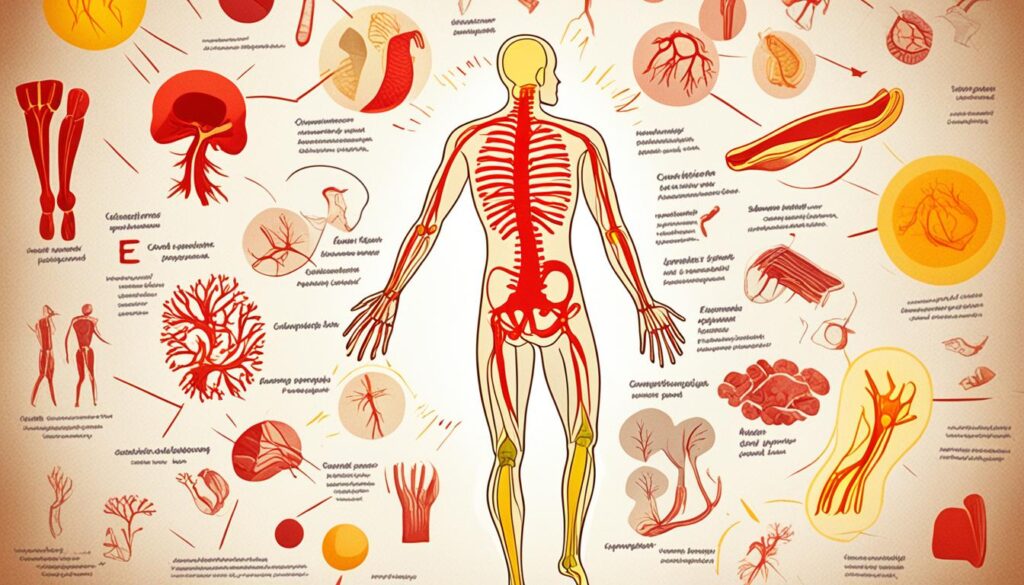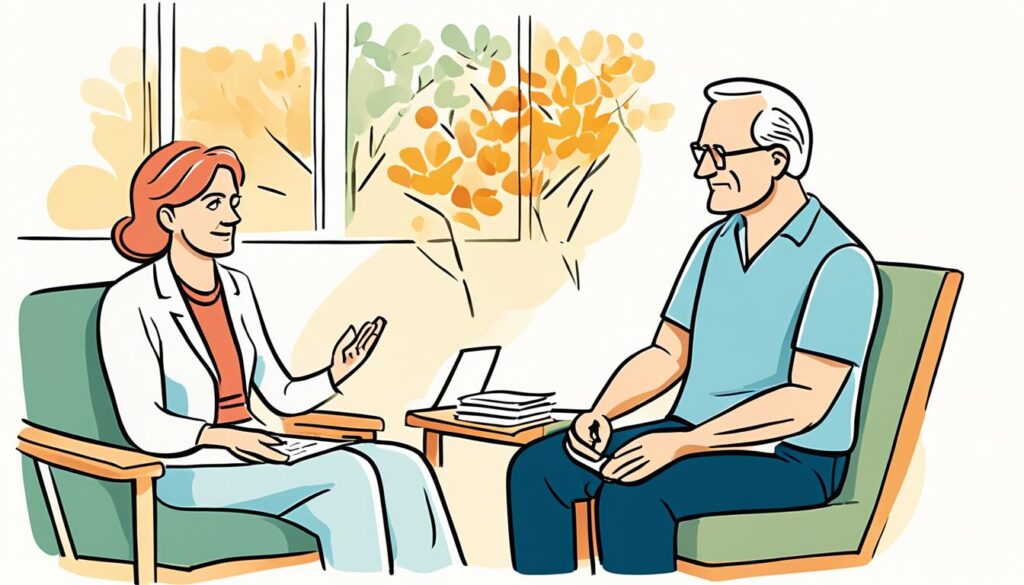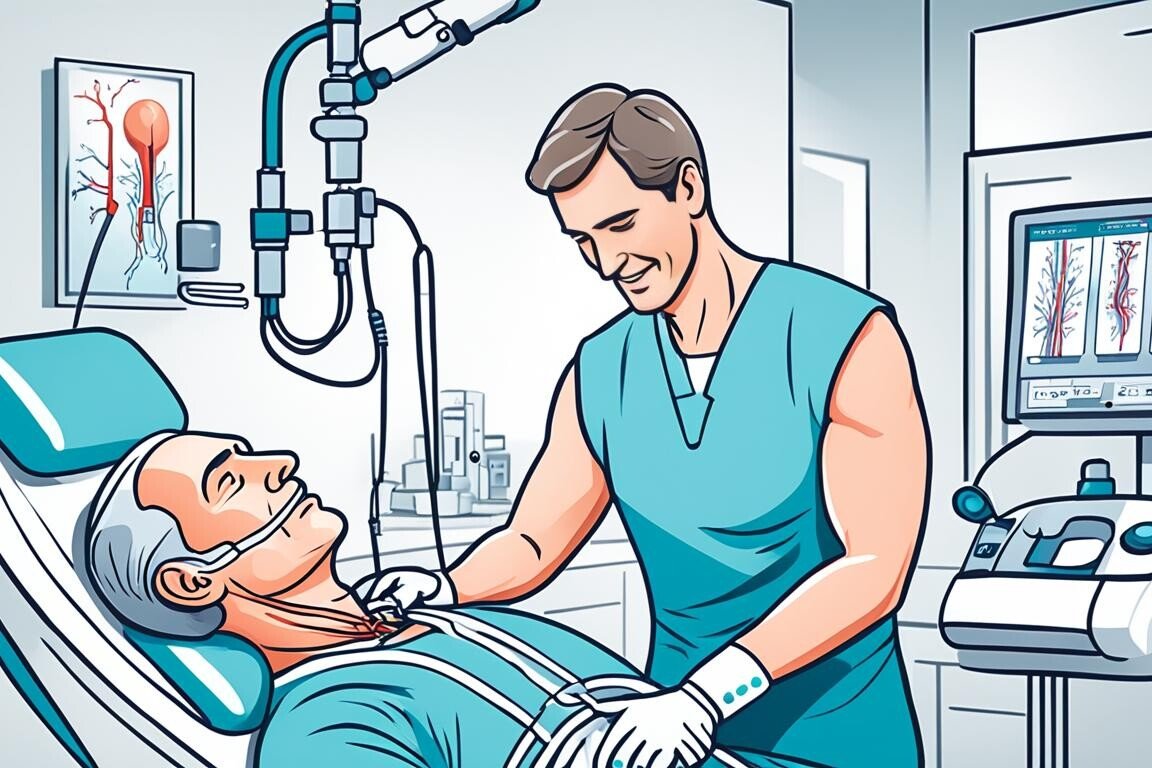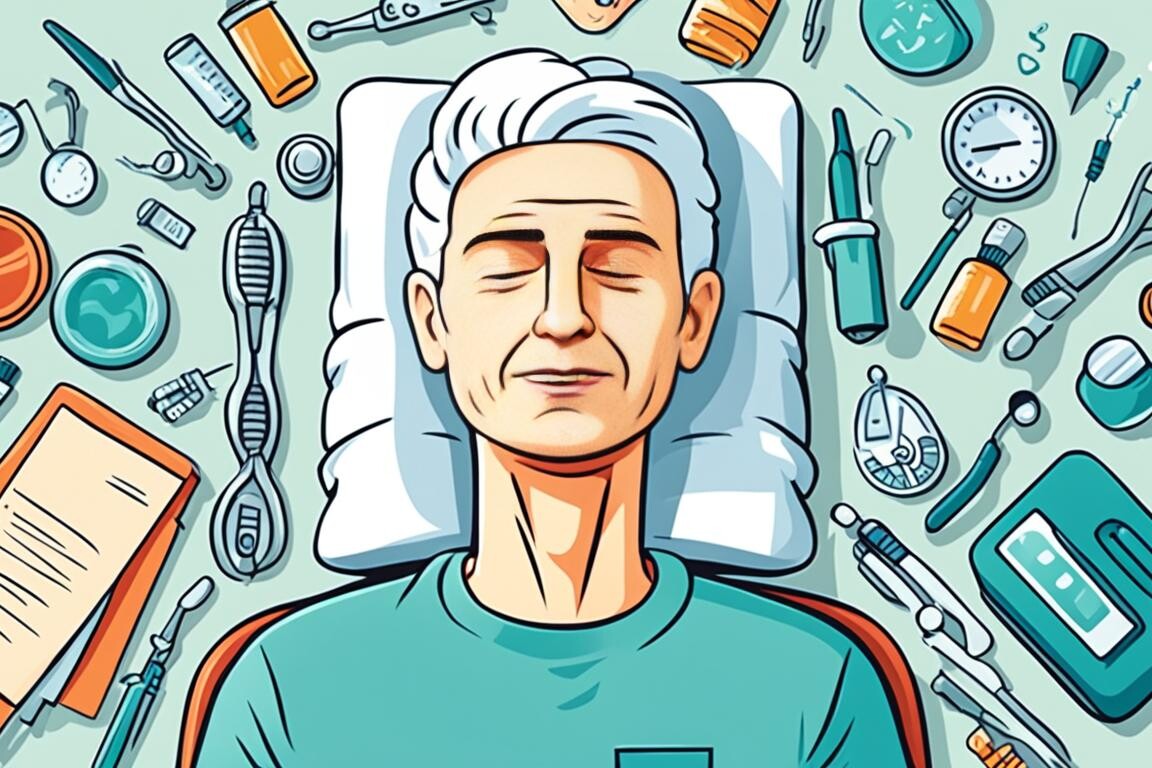If you’re facing ongoing or chronic pain, you’re not alone. Pain management clinics in India are here to help people like you. They offer various treatments and a team approach to tackle spine, joint, and neuropathic pain.
At these clinics, you’ll meet a team of experts. They include pain specialists, physical therapists, and mental health professionals. Together, you’ll create a plan to manage your pain. This plan might include medicines, regenerative treatments, and therapies to lessen your pain. The aim is to help you live a better life, doing what you love and working without pain.
Pain is complex, and the clinic team will figure out what’s causing yours. They’ll create a treatment plan just for you. Whether it’s back pain, joint pain, or neuropathic pain, these clinics offer the care and support you need. They help improve your overall health and well-being.
Table of Contents
ToggleUnderstanding Pain Management
Pain is complex and varies from person to person. Many suffer from “invisible” conditions that cause chronic pain. Finding complete relief may not always be possible. Your pain management team will create a plan just for you.
What Pain Management Involves
Pain management aims to lessen your pain and improve your life. It combines different methods, such as:
- Medications (e.g., nonopioids, weak opioids, combination opioids, strong opioids, adjuvant treatments)
- Physical and occupational therapy
- Psychotherapy
- Complementary and alternative therapies (e.g., acupuncture, bioelectric therapy)
- Interventional pain management procedures (e.g., nerve stimulation, injections)
Types of Pain: Acute vs. Chronic
There are two main pain types:
- Acute pain is short-term and goes away as the condition heals. It can come from injuries, surgery, or illnesses.
- Chronic pain lasts for a long time and is linked to conditions like arthritis, back pain, and fibromyalgia. It’s harder to manage.
Your team will create a plan to help with your pain, whether it’s acute or chronic. This will improve your well-being.

Who Needs Pain Management?
Pain can really change how you live your life, whether it’s sharp or ongoing. Many people need help managing pain due to injuries, infections, or diseases. Conditions like arthritis, autoimmune conditions, cancer, neuropathic pain, chronic pain disorders, and spine or spinal cord-related conditions or injuries often cause chronic pain.
Anyone who can’t shake off or finds pain too much can benefit from pain management. In fact, over 100 million Americans and more than 1.5 billion people worldwide suffer from chronic pain. This pain can make it hard to sleep, focus, have energy, and enjoy life. A good pain management plan can make a big difference, helping you feel better every day.
Common Conditions Causing Chronic Pain
- Arthritis
- Autoimmune conditions (e.g., rheumatoid arthritis, lupus)
- Cancer
- Neuropathic pain (e.g., nerve damage, diabetic neuropathy)
- Chronic pain disorders (e.g., fibromyalgia, complex regional pain syndrome)
- Spine or spinal cord-related conditions or injuries
Pain management clinics can help by focusing on the root causes of pain and creating a personalized treatment plan. This way, people can take back control of their lives and find relief from their pain.

Your Pain Management Team
If you’re living with chronic pain, you might have a team of specialists working to help you. This team includes healthcare providers with different skills to meet your needs.
Specialists Involved in Your Care
Your pain management team might include:
- Pain management specialists, like anesthesiologists or physiatrists, who focus on treating pain
- Specialists for other conditions you might have, such as rheumatologists, neurologists, or oncologists
- Nurses who help with treatments and keep track of your progress
- Mental health experts, like psychologists or counselors, to help with the emotional side of pain
- Physical and/or occupational therapists to boost your strength and ability to do daily tasks
- Social workers who connect you with support and resources
Diagnostic Tests and Assessments
Your team might suggest tests and assessments to understand your pain better and create a treatment plan. These can include:
- Physical exams to check your symptoms and how you move
- Imaging tests like X-rays, MRIs, or CT scans to find any underlying issues
- Electrodiagnostic studies, such as EMG or nerve conduction studies, to test nerve function
- Evaluations of how your pain impacts your daily life, like work, sleep, and physical activity
Working with your pain management team ensures your pain is diagnosed right. You’ll get a detailed treatment plan to help manage your chronic pain and improve your life.

At-Home Pain Relief Techniques
Finding ways to ease chronic pain at home can change your life. Techniques like the RICE method and using heat or cold can help. Also, eating right, staying active, and sleeping well can make a big difference in how you feel.
The RICE method is a popular way to ease pain at home. It means resting the area, using ice to lessen swelling, and compressing it to keep it stable. Elevating the area helps with swelling and drainage. Heat therapy can relax muscles and boost blood flow, aiding in healing.
Being active and doing strength training is key for managing chronic pain. Gentle exercises and stretches can make you more flexible and stronger. This can lessen pain and make you feel better. Yoga and tai chi are also great for managing pain.
While home remedies can help, it’s important to talk to your doctor. They can help create a plan that fits your needs and concerns.

Using self-care and getting professional advice can help you manage your chronic pain. This approach can improve your life quality significantly.
Physical and Occupational Therapy
If you’re dealing with chronic pain, consider physical and occupational therapy. They can be key to managing your pain. Physical therapy helps with movement, while occupational therapy makes daily tasks easier.
Physical therapists (PTs) help increase your mobility and reduce pain. They create therapeutic exercise plans to strengthen muscles and improve flexibility. PTs also use heat, cold, and electrical stimulation to help with pain.
Occupational therapists (OTs) help you adjust your daily life to lessen pain’s impact. They suggest assistive devices and modify work areas. OTs teach pain-relieving techniques for everyday activities like bathing and cooking.
Both physical and occupational therapy are great for managing conditions like arthritis and fibromyalgia. They work with your pain management team to create a plan. This plan helps with physical therapy for pain and occupational therapy for pain.

Visits with a PT or OT usually last up to 45 minutes. They also offer virtual sessions for those who can’t make it in person. Some clinics have group programs for people with chronic pain.
Physical therapy for pain and occupational therapy for pain can help you take back control of your life. Adding these therapies to your plan lets you find new ways to handle chronic pain and stay active.
Psychotherapy for Pain Management
If you’re living with chronic pain, psychotherapy can help. It’s a powerful tool for managing symptoms and improving well-being. Cognitive behavioral therapy (CBT) is especially effective for those with persistent pain.
CBT helps you change thoughts and behaviors that add to your pain. You’ll learn skills to handle the emotional and psychological parts of chronic pain. This can make the physical pain worse.
- CBT teaches relaxation techniques like deep breathing and mindfulness to manage pain-related stress and anxiety.
- You’ll work on changing negative thoughts that make your pain feel worse and affect your daily life.
- CBT also helps you find ways to do meaningful activities even with pain, improving your life quality.
Studies show that psychotherapy, like CBT, can be as good as surgery for chronic pain relief. Most patients feel better after a few sessions with a psychologist. By focusing on mental health and emotions, you can manage pain more effectively and improve your well-being.

You don’t have to deal with chronic pain by yourself. Getting support from a mental health professional is a key step in managing your pain and getting your life back.
Complementary and Alternative Therapies
When dealing with pain, many people turn to complementary and alternative therapies. These include acupuncture, massage, chiropractic adjustment, herbal remedies, and mind-body practices like meditation and yoga. They are often used with traditional treatments to help with chronic pain.
Acupuncture is a traditional Chinese practice that the World Health Organization recognizes for treating over 30 conditions. It’s shown to be effective for headaches, low back pain, menstrual cramps, carpal tunnel syndrome, and fibromyalgia.
Chiropractic adjustment is a common treatment for back pain without surgery. It may also help with headaches, neck pain, certain arm and leg conditions, and whiplash injuries.
- Massage therapy is now more popular for chronic back and neck issues.
- Therapeutic touch and reiki healing aim to activate self-healing to lessen pain.
- Changing your diet, like eating raw veggies or low-fat vegetarian, can help with fibromyalgia and premenstrual symptoms.
- Supplements like glucosamine sulfate, chondroitin sulfate, and fish oils might help with pain management.
Even though there’s limited science on these therapies, many find them useful for chronic pain with traditional treatments. Always talk to your healthcare provider to find the best plan for you. They can help ensure these therapies are safe and effective.
Medical Procedures for Pain Relief
Managing chronic pain often means trying different treatments. Options like nerve stimulation and interventional pain management can help. These methods aim to ease your pain and make life better.
Nerve Stimulation Techniques
Techniques like TENS and peripheral nerve stimulation don’t need surgery. They use electrical impulses to block pain signals. Spinal cord stimulation is another option. It involves a device that sends electrical currents to the spinal cord to reduce pain.
Interventional Pain Management Options
These procedures go right to the heart of the pain. Your team might suggest trigger point injections, Botox injections, or implantable devices. These methods are less invasive and aim for lasting relief and better function.

Working with your pain management team helps you find the right procedure for you. These treatments are key to managing your pain. They help you take back control of your health and well-being.
Medications for Pain Management
When you have chronic pain, your doctor might suggest different medicines to ease your pain. These can be over-the-counter drugs like acetaminophen or NSAIDs. Or, they could be prescription drugs such as muscle relaxants, anti-anxiety medicines, antidepressants, or opioids for a short time.
NSAIDs can raise the risk of heart attacks and strokes if taken often at high doses. Acetaminophen is usually safer. But, taking too much or mixing it with alcohol can harm your liver and kidneys over time.
Corticosteroids are prescription drugs that can cause weight gain, stomach problems, mood changes, and trouble sleeping. They can also weaken your immune system, make bones and skin thinner, and raise your blood sugar levels. Opioids help with pain but can be addictive, especially if used for a long time.
Antidepressants, like tricyclic antidepressants, are good for nerve pain. SSRIs and SNRIs have fewer side effects. Anticonvulsants help with pain and are usually well-tolerated. Their common side effects include dizziness, sleepiness, and gaining weight.
Your doctor will help you find the best mix of pain medications, pain management pharmacotherapy, and opioid alternatives for pain. They aim to give you the most effective and safe pain relief. This way, they reduce the risk of addiction or serious side effects.
Clinical Trials and Research
Researchers are looking into new ways to manage pain. By joining a clinical trial, you could get access to new treatments. These treatments might help with your chronic pain.
The National Institutes of Health (NIH) HEAL Initiative leads in pain management research. It supports new trials and grows existing ones for non-addictive pain treatments. The Advancing Health Equity in Pain Management program works to make pain care fair for everyone.
The Acute to Chronic Pain Signatures program aims to predict who might get chronic pain. The Back Pain Consortium (BACPAC) is studying chronic low back pain to find better treatments.
The Discovery and Validation of Biomarkers, Endpoints, and Signatures for Chronic Pain program is finding biomarkers for pain. The Early Phase Pain Investigation Clinical Network (EPPIC-Net) tests non-addictive treatments for pain.
Your healthcare team can tell you about pain management clinical trials you might join. This could give you access to emerging pain treatments and help pain research.
Pain Management Clinic
Dealing with chronic pain can feel overwhelming. A pain management clinic offers a way to get personalized, evidence-based treatment. These clinics have a team of pain experts who work together to help you.
Over 250,000 patients trust these clinics across India. They have five modern facilities in different places. Doctors like Dr. Dhruv Bibra and Dr. (Prof) G.P. Dureja lead them. They have 20 and 40 years of experience, respectively. Their goal is to ease your pain and make life better.
Chronic pain can make everyday tasks hard, like walking or sleeping. With more older people and those with chronic conditions like diabetes and arthritis, pain care is crucial. These clinics offer treatments that mix medicine, procedures, lifestyle changes, counseling, and education to help you.
At a pain management clinic, you get a treatment plan made just for you. They use special injections and procedures like Radiofrequency Ablation and Spinal Cord Stimulators. These methods are safe, done with local anesthesia, and follow international standards. They help you recover quickly and reduce hospital stays.
The team at these clinics includes experts in anesthesiology, physical therapy, and psychology. They work together to find the best way to manage your pain and boost your health.
Multimodal Approach for Optimal Results
Treating chronic pain often requires more than one method. The best plans combine different treatments, like multimodal pain management, medicines, physical therapy, and more. This way, pain clinics can find the best mix of treatments for you.
A multimodal pain management plan might include:
- Medications (both opioid and non-opioid)
- Interventional pain management techniques, such as nerve blocks and spinal cord stimulation
- Physical therapy and occupational therapy
- Psychotherapy, including cognitive-behavioral therapy
- Complementary and alternative therapies, like acupuncture and massage
Customizing a treatment plan for you is key. Pain clinics aim to improve your life quality with this approach. It’s vital for handling complex chronic pain well.
Resources
If you’re dealing with chronic pain, there are many resources to help you. Start by talking to your doctor about seeing a pain management clinic. These clinics have a team ready to help you manage your pain.
There are also patient groups, online forums, and educational materials for support. Sites like DrChandrilChugh.com offer info on chronic pain and treatment options. You don’t have to go through chronic pain alone; there’s help out there to make life better.
Look into all the resources you can use. This includes getting advice from doctors, joining support groups, or finding online learning materials. With the right support and strategies, you can manage your chronic pain and improve your life.
FAQ
What is pain management?
Pain management uses medicines, procedures, exercises, and therapy to control pain. Specialists may suggest one or more methods to prevent, lessen, or stop pain. You might get care in a pain clinic, a doctor’s office, or a hospital.
What is the difference between acute and chronic pain?
Acute pain is short-term and goes away when you heal. Chronic pain lasts for months or years. The goal is to improve your life and daily activities, like working or enjoying hobbies.
Who can benefit from pain management?
Anyone with pain, whether it’s new or long-term, can use a pain management plan. Pain signals a wide range of injuries, infections, and diseases. This includes arthritis, autoimmune conditions, cancer, and more.
What is a pain management team?
What are some at-home pain relief techniques?
How can physical and occupational therapy help with pain management?
How can psychotherapy help with pain management?
What complementary therapies can help with pain management?
What medical procedures can help manage pain?
What medications can be used for pain management?
How can I participate in pain management research?
What is a pain management clinic?
What is a multimodal approach to pain management?
Where can I find resources for managing chronic pain?
If you’re dealing with chronic pain, there’s help available. Talk to your doctor about a pain management clinic referral. Look for support through patient groups, online forums, and educational materials. You don’t have to face chronic pain alone.
Source Links
About The Author

This article is medically reviewed by Dr. Chandril Chugh, Board-Certified Neurologist, providing expert insights and reliable health information.
Dr. Chandril Chugh is a U.S.-trained neurologist with over a decade of experience. Known for his compassionate care, he specializes in treating neurological conditions such as migraines, epilepsy, and Parkinson’s disease. Dr. Chugh is highly regarded for his patient-centered approach and dedication to providing personalized care.
→ Book a consultation to discover which remedies suit your needs best.




